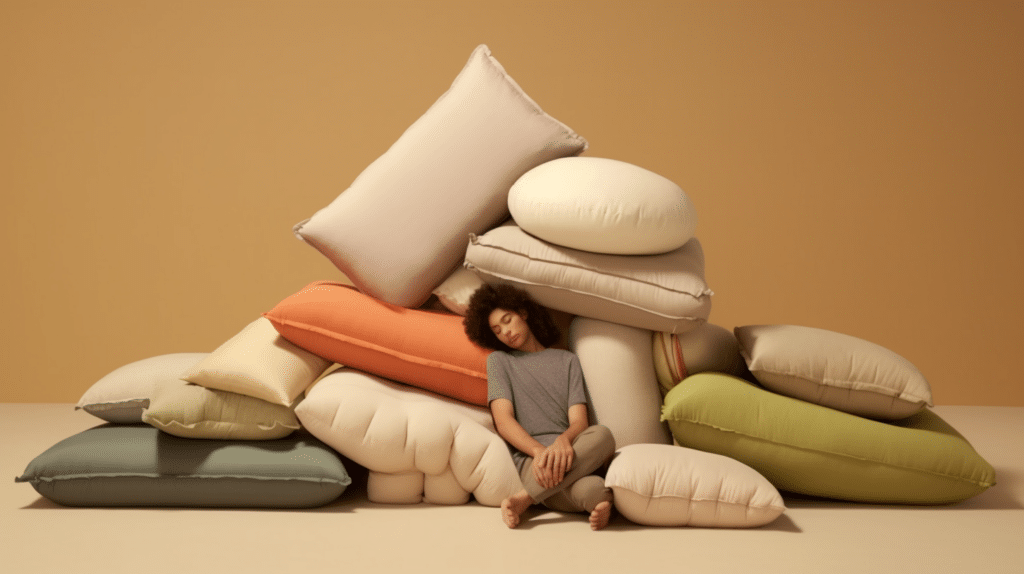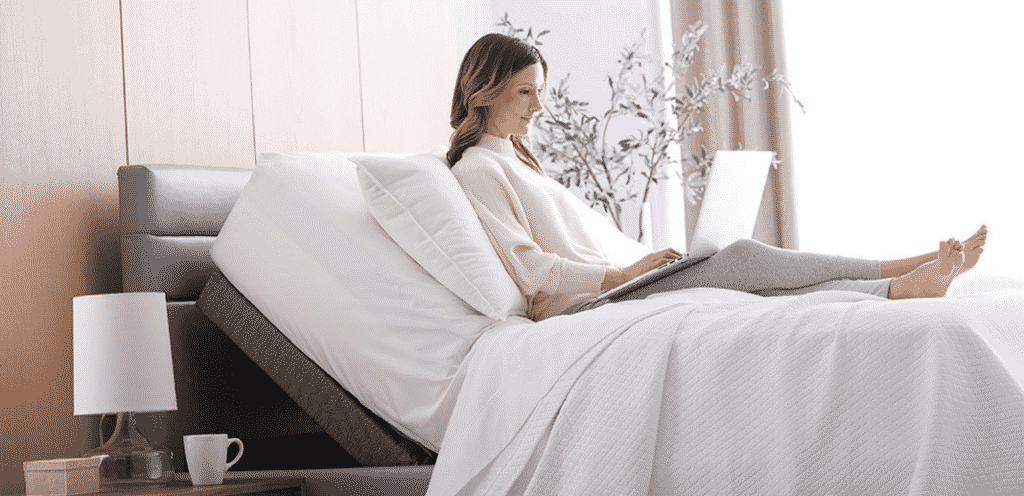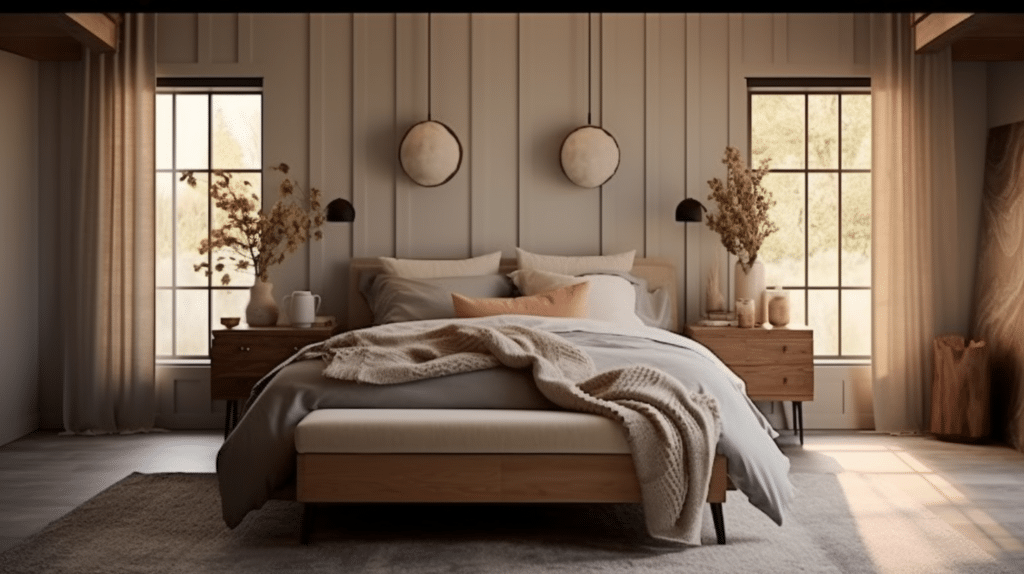Our editors independently researched the best products online to produce this list. We may receive commission on purchases made from the links below but this will never affect our product choices. Click here to read our disclosure.
Are you waking up each morning with mysterious bites? It can be confusing, irritating, and even a little gross, right? The culprit may be bedbugs, and what you do next will determine whether you continue to battle an infestation or quickly resolve the issue.
There are a few options to consider: you could dispose of the mattress (and possibly the entire bed in a worst-case scenario), or you could hire a professional to expertly eliminate the bugs. However, these options can be quite costly and may be considered excessive in some cases.
Instead of going down that path, let’s focus on finding a more affordable yet equally effective solution. Opting for the best bed bug mattress cover can yield excellent results at a fraction of the cost. It will protect you from unpleasant bites and prevent the need to part with your expensive mattress that you’ve come to love.
With this in mind, let’s explore some of the most effective bed bug mattress covers available on the market. We’ll discuss the key features to look for and then provide reviews of the top five options.
- LINENSPA – (Budget Option)
- SureGuard – (9-12 inch Deep)
- SafeRest Premium – (Lab Certified Bug-Proof)
- Eco Living Friendly Evolon
- Cushybeds Premium – (Lifetime Warranty)
How We Compared Bed Bug Covers For Mattresses
When comparing the best bed bug mattress covers, our key considerations were effectiveness, durability, ease of use, comfort, and breathability.
Effectiveness is the primary concern when dealing with bed bugs. We looked for mattress covers that are specifically designed to prevent bed bugs from entering or escaping, with tight zippers and secure seals.
Durability is also vital, as a bed bug mattress cover needs to withstand regular use and washing without tearing or losing its protective properties. We assessed the durability of the fabric and the construction of each cover.
Ease of use is important, especially when it comes to installing and removing the cover for washing. We examined the design of each cover to see how straightforward it was to use.
Despite its practical purpose, a bed bug mattress cover still needs to be comfortable. We looked at the texture of the fabric and the potential noise it might produce when moved on, as these factors can affect sleep quality.
Breathability is essential for maintaining a comfortable sleeping temperature. We assessed whether each cover allowed for sufficient airflow while still providing effective protection against bed bugs.
Lastly, we incorporated customer reviews to gain insights into each cover’s real-world performance, and evaluated the terms of any warranties or guarantees offered. By considering all these factors, we were able to identify the best bed bug mattress covers available in the market.
The Best Bed Bug Mattress Covers In-Depth
LINENSPA Mattress Encasement
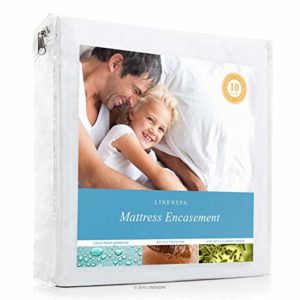
The first of our reviews is from Linenspa, a long-established bedding company. This one is a zippered mattress encasement made of inner polyurethane material with a soft, breathable polyester top. It’s ultra-thin but protects all sides of the mattress, not just the top and bottom.
It’s spill-proof and moisture resistant. One of the biggest reasons that mattress encasements fail to solve a bed bug problem is that users take them off the mattress. You don’t have to remove this encasement to launder; wipe down the surface if you have a spill. Bed bugs can live for up to a year with no food, so watch out.
The LINENSPA is free of vinyl and safe for kids. Polyester doesn’t irritate vinyl, but it will offer a quiet night of sleep without becoming sweaty or feeling like an old hospital bed cover. There’s absolutely no crinkling sound, and it doesn’t feel like plastic at all.
The zippered closure fits mattresses up to 12 inches deep. The material around the zipper creates a moisture barrier and also helps bedbugs from squeezing through. One downside is that the zipper isn’t completely sealed with a protective flap to prevent accidental opening.
If you ever did feel the need to launder the cover, it is machine washable. Wash it in cold settings and tumble dry low, nothing fancy. The good thing about this encasement is you can wipe it clean from time to time without bothering with the washing machine.
Another downside is the material does add some heat to the mattress. The inner polyurethane traps body heat and sends it back. The cover relies on the polyester top to mitigate some of the body heat and restore a more natural temperature. If you find yourself sweating during the night without a cover, you’ll find this one warm and may want to consider some of the alternative bed bug mattress cover reviews.
- Quiet material
- Protects mattresses up to 12 inches deep
- Easily machine washable
- Moisture resistant and spill proof
- No protective zipper flap
- Retains heat
SureGuard Mattress Encasement
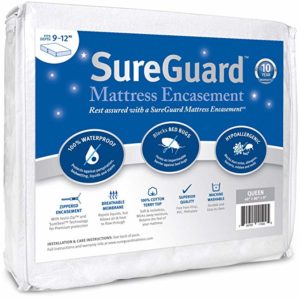
SureGuard’s encasement is a three-layered cover with a polyurethane backing, polyester covers on five sides, and cotton terry on the top. It’s breathable, more so than other protectors on the market, and doesn’t cause an increase in temperature during your sleep.
The SureGuard is entirely moisture and spill-proof, so if your bed is already infested, there’s no need to remove the cover for the recommended time to kill bugs inside. Wipe things down when you need to.
You can use it with memory foam mattresses as well for other types of allergen protection. The encasement works with beds up to 12 inches deep. The durable polyurethane with stretchy polyester helps prevent tears when you’re getting things set up.
One of the best features of the encasement is the zipper. It’s a super fine zipper with SureGuard’s Invisi-zip and SureSeal technology. It prevents any breaches in the cover and completely seals the mattress. There is also a protective flap that folds down over the zipper head to prevent accidental openings.
The cotton-top provides a more comfortable sleep surface that’s quiet and doesn’t feel like plastic. The cotton grips the sheets in the same way a regular mattress would, so we didn’t notice any slippage. It does have a faint noise when you’re moving around on the bed but isn’t obnoxious.
It’s free of vinyl and doesn’t have any smell. We recommend washing and drying the cover to soften the cotton top and make it more moisture resistant. Be sure to wash it in cold water and dry on low heat. High heat can damage its ability to repel moisture.
The SureGuard can be tricky to put on by yourself. It’s much easier if you have a partner who can help steady the mattress as you slide the protector over. Check all the seams once the protector is in place to make sure everything is still sealed.
- The cotton top feels natural
- A zipper protector for accidental openings
- The zipper is superfine and sealed
- Keeps the heat down during sleep
- Cotton-top helps hold sheets in place
- Noise is more audible than other covers
- Specific wash settings can ruin moisture repellency
SafeRest Premium Zippered Mattress Encasement
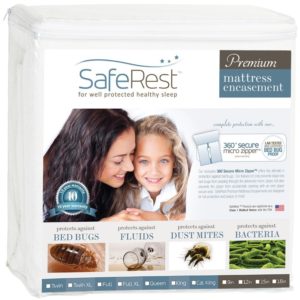
SafeRest’s encasement is a polyurethane moisture resistant layer with a soft cotton terry top cover. It’s breathable, and the cotton helps wick moisture away from your body without allowing any to penetrate the inner layers of the mattress.
The SafeRest is spill-proof, so you don’t have to remove the cover to launder. You can wipe things down with a soft cloth. If you do need to clean the encasement, simply wash the SafeRest on cold water setting with regular household detergents (no bleach) and dry on low.
One significant benefit of the encasement is the zipper. It’s ultra-fine and has a 360-degree velcro closure that wraps around the zipper to prevent accidental openings and to seal any last gaps around the zipper head.
The encasement was lab explicitly tested for bed bugs and allergens. The zipper, in particular, has been certified as effective against preventing bed bugs from escaping or getting into the mattress in the first place.
The noise level is nearly zero. Some mattress protectors have a plastic-like feel and sound, but this one didn’t feel any different than a traditional mattress topper (one made for comfort).
The top layer does an excellent job of keeping the heat down, but because the rest of the bed isn’t cotton, it can store heat if you tuck your sheets and blankets into the bottom and sides of the bed.
One downside of the encasement is that it tends to fit a little more loosely on a standard sized mattress. While this doesn’t affect the seal at all, it is annoying to have extra fabric hanging loosely. You could tuck the extra under the bed to help tighten things up.
The certifications for all stages of bed bug life are a nice touch, plus the allergen-proof fabric. Also, the material seems more durable without adding too much noise or feeling like plastic. Possibly the best bed bug mattress encasement in this lineup so far, the SafeRest doesn’t fail to impress.
- Independently certified for all bed bug stages of life
- Hypoallergenic material
- 360-degree enclosed Velcro zipper cover
- Ultra-fine zipper
- No noise
- Sleeps a little too warm if you tuck in your bed linens
- Not as fitted on a standard mattress
Eco Living Friendly Evolon Allergy Mattress Encasement
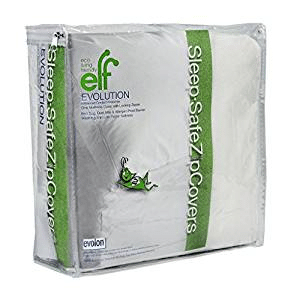
Eco Living Friendly’s protector is an encasement that contains no toxic off-gas, PVC, or chemical post-treatments. It provides total protection from bed bugs, dust mites, and other allergens, and has an OekoTex 100 class 1 certificate, meaning the production and materials are environmentally friendly.
The material uses German engineering for filtration of 1 micron, a barrier system that allows air through, so the fabric will breathe, but bed bugs cannot get into the mattress or out.
It absorbs up to 400% of its weight in moisture, making it suitable for wicking sweat away from your body. It dries quickly and doesn’t need to be washed. If you do need to clean it, it’s okay to launder with ordinary household detergent and dry on low. The manufacturer recommends cleaning the ELF once before use to soften up the fabric.
It’s bleach safe and maintains performance even after being washed. If you mess up and clean it on hot, it won’t strip the seal either, as it’s made to withstand some wear and tear in the laundry.
One potential downside is that the zippers don’t have a cover to prevent opening and closing accidentally. If you don’t move around a lot while you’re sleeping, it might not matter that much, but be sure to check the zipper regularly.
As a bonus, the material helps regulate temperature. It doesn’t get as hot as other types of mattress covers because microfilaments create a breathable layer. It doesn’t cause a lot of noise, and grips sheets a lot like a bare mattress would so you aren’t adjusting your top sheet.
- Eco-friendly certification
- 1-micron filtration
- Bleach safe
- Can withstand accidental hot water washings
- No zipper cover
- Tricky to get onto a mattress
Cushybeds Premium Mattress Protector
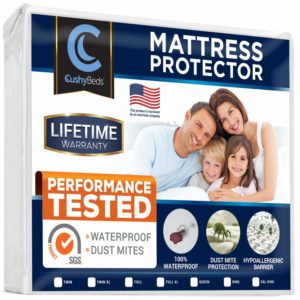
If you don’t need full-scale protection, an anti-bed bug mattress encasement might be a good choice. Encasements can be tricky to get on the bed and are a nuclear option for a full-blown infestation. If you’ve treated your mattress and frame already, and need a layer of protection for any outliers, this is a good choice.
It goes on the bed like a fitted sheet, so one person can put it on. It’s made of 80% cotton and 20% polyester terry cloth, making it soft and breathable with no noticeable temperature difference. It has a thick pocket that fits mattresses up to 18 inches deep.
The CushyBeds Premium is 100% waterproof but doesn’t feel like plastic because of the polyurethane membrane and the terry cloth top. It has microscopic divots that allow air to pass through but blocks liquids.
It traps mites, mold, and other microscopic organisms on the surface of the cover where you can safely wash them away. The manufacturer recommends washing the cover every three months or so to prevent buildup and triggering allergies.
It’s washable with ordinary household detergents. Wash on cold and tumble dry low so that you don’t degrade the waterproof layer. Each time you wash it, it gets softer and more comfortable. There’s no noise, and it doesn’t feel like a plastic liner the way some waterproof liners do.
One downside is that it doesn’t encase your mattress fully. If you want to get rid of bedbugs without using sprays and chemicals, this mattress cover isn’t going to do that. It can protect you against stragglers who haven’t been affected by the spray treatments, but that’s about it.
If you want a simple layer between you and a previously infested mattress and prevent some of the chemicals from getting into your skin through the sheets, this is a good option. It’s simple to use and protects your mattress and you.
- Easy to put on the mattress alone
- No noticeable temperature difference
- 100% waterproof and allergen-proof
- Washes clean to get rid of trapped allergens
- Isn’t a full encasement and won’t get rid of bedbugs naturally
How To Choose The Best Mattress Cover For Bed Bugs
Are you tired of waking up covered in itchy red bites? Are you constantly on edge, wondering if those tiny bugs are lurking in your mattress? If so, it’s time to invest in a bed bug mattress cover. These covers are specially designed to protect your mattress from infestations and provide you with a peaceful night’s sleep. But with so many options available, how do you choose the best one for your needs?
In this article, we will guide you through the process of selecting the perfect bed bug mattress cover. We’ll start by helping you understand bed bug infestations and how to identify their signs. Then, we’ll explore the different types of covers available and discuss important factors such as material, construction, waterproofing, breathability, allergen protection, hypoallergenic options, ease of installation and cleaning, as well as sizing and fit for different mattress types. By the end of this article, you’ll have all the information you need to confidently choose the best bed bug mattress cover that will keep those pesky critters at bay and ensure a restful night’s sleep every night.
Understanding Bed Bug Infestations
You need to understand the severity of bed bug infestations and how they can quickly turn your peaceful sanctuary into a nightmare-infested zone. Bed bugs are small, parasitic insects that feed on human blood and can cause irritating bites. Prevention is key when it comes to dealing with these pests, as once they infest your mattress, it becomes much harder to eradicate them. Understanding their lifecycle and hiding places is crucial in order to effectively treat an infestation. Bed bugs go through several stages of development, from eggs to nymphs and finally adult bugs. They tend to hide in cracks and crevices near where people sleep, such as mattress seams, headboards, and furniture joints. By knowing about their behavior and habits, you can choose the best bed bug mattress cover that will provide maximum protection against these relentless creatures.
Identifying the Signs of Bed Bugs
Easily spot the telltale signs of these unwanted pests lurking in your sleeping space. If you wake up with red, itchy bites on your body, especially in a linear pattern, it could be a sign of bed bug bites. Another indicator is finding small, translucent eggs or shed exoskeletons in the crevices of your mattress or furniture. Bed bugs are expert hiders and can be found in various hiding spots such as cracks and crevices, behind loose wallpaper, or even inside electrical outlets. Conducting a thorough bed bug inspection by checking these common hiding areas can help confirm their presence. If you do find evidence of an infestation, it’s important to seek professional bed bug treatment to effectively eliminate them from your home.
Types of Bed Bug Mattress Covers
Protect your sleeping sanctuary with a reliable shield against those relentless nocturnal invaders – bed bugs. When it comes to choosing the best bed bug mattress cover, there are several options to consider. First, you want to find a cover that is cost effective yet still provides effective protection against bed bugs. Look for covers made from eco-friendly materials, as this not only benefits the environment but also ensures that you are not exposed to harmful chemicals while you sleep. Additionally, make sure to choose a cover that is extra durable, as it will need to withstand regular use and frequent washing. It’s also beneficial to select a cover with anti-bacterial properties, which can help prevent the growth of bacteria and allergens on your mattress. Lastly, don’t forget about bed bug prevention tips such as regularly inspecting your mattress and bedding for signs of infestation and vacuuming your bedroom frequently. By taking these steps and investing in a quality mattress cover, you can ensure a peaceful and bed bug-free night’s sleep.
Material and Construction Considerations
When it comes to selecting the right material and construction for your mattress cover, don’t overlook the importance of durability and eco-friendly options. You want a cover that will provide durability and longevity, ensuring that it will last for years to come. Look for a mattress cover with a zippered closure, as this will help to keep bed bugs out and prevent them from infesting your mattress. Additionally, consider a cover that is specifically designed for bed bug proofing, as this will provide an extra layer of protection. Another important consideration is heat resistance, as bed bugs are known to be sensitive to high temperatures. Lastly, choose a mattress cover that is comfortable and soft to ensure a good night’s sleep.
Waterproof and Breathable Features
Don’t forget to prioritize the waterproof and breathable features of your mattress cover – you’ll want a material that not only keeps moisture out, but also allows air to circulate for ultimate comfort and freshness. When it comes to moisture control, a waterproof mattress cover is essential in preventing any liquids or spills from seeping into your mattress and causing damage. Additionally, a breathable fabric will ensure that heat and sweat are not trapped, providing a more comfortable sleeping experience. Look for materials such as polyester or polyurethane with breathable properties. It’s important to choose a mattress cover that is durable and long-lasting, as it will be subjected to regular use and frequent washing. Opting for cost-effective options like vinyl or plastic covers may provide some protection against bed bugs but can lack breathability and comfort. Consider investing in higher-quality options like hypoallergenic fabrics with specialized coatings that offer both bed bug prevention and breathability, ensuring you get the best of both worlds without compromising on durability.
Allergen Protection and Hypoallergenic Options
Investing in a high-quality mattress cover made from hypoallergenic materials can significantly reduce allergens and provide a more comfortable sleep environment. These covers offer dust mite protection, anti-allergy properties, and bed bug prevention, making them ideal for those with allergies or sensitivities. The hypoallergenic materials used in these covers create a barrier that prevents allergens from seeping into the mattress, helping you breathe easier and reducing the risk of allergic reactions. Additionally, these covers are easy to maintain as they can be washed regularly to remove any accumulated dust or allergens. They also offer comfort and durability, ensuring a good night’s sleep while protecting your mattress from wear and tear.
Ease of Installation and Cleaning
Make your life easier with a mattress cover that is simple to install and effortless to clean, allowing you to spend more time enjoying a fresh and cozy sleep surface. When choosing a bed bug mattress cover, consider the ease of installation as an important factor. Look for covers that come with clear installation instructions and are easy to put on your mattress without any hassle. Additionally, it’s essential to consider the cleaning frequency of the cover. Opt for a cover that can be easily removed and washed regularly to maintain hygiene. Durability is another crucial aspect to keep in mind. Choose a cover made from high-quality materials that can withstand regular use and washing without tearing or losing its effectiveness over time. Cost considerations are also important, so make sure to compare prices and features before making a purchase. Lastly, read customer reviews to get insights into other people’s experiences with the product you are considering. This will help you make an informed decision about which bed bug mattress cover is best suited for your needs.
Sizing and Fit for Different Mattress Types
Finding the perfect fit for your mattress can transform your sleep experience, ensuring a snug and secure embrace that will leave you feeling comforted and supported throughout the night. When choosing a bed bug mattress cover, it is essential to consider its compatibility with your specific mattress. Start by identifying the size of your mattress, whether it’s twin, full, queen, or king. Additionally, take into account the thickness of your mattress as some covers may be designed to accommodate thicker mattresses better. Consider the shape of your mattress as well; for example, if you have a pillow-top or memory foam mattress, ensure that the cover is designed to fit these shapes properly. Lastly, consider the level of support provided by the cover – look for options that offer waterproofing or allergen protection if these are concerns for you. By considering these factors when selecting a bed bug mattress cover, you can ensure an optimal fit that enhances both your sleeping environment and peace of mind.
Conclusion
Our top choice for the best bed bug mattress cover is the SafeRest. It fulfills all our requirements within a budget we can afford.
One significant advantage is that it’s the only cover on our list that has received independent certification for effectively protecting against bed bugs at every stage of their life cycle. This gives us tremendous confidence that this encasement can help us eliminate a bed bug infestation without the need to discard our mattress.
We were also impressed by the superfine zipper teeth and seams. They provide a 360-degree Velcro closure, ensuring that bed bugs cannot escape through small openings in the zipper. Additionally, we can rest easy knowing that the zipper will stay securely closed without any accidental openings. We trust that the cover will remain in place throughout the year or for as long as it remains on the bed.
Another noteworthy feature is its quietness, which was a must-have for us. There is minimal noise as we move around, and the top of the cover feels seamlessly integrated with the mattress. However, it’s worth mentioning that the material might be slightly oversized for standard-sized beds. Nonetheless, once everything is tucked in, it shouldn’t pose any issues.
Considering the price and quality of materials, the SafeRest offers the best chance for you to eliminate bed bugs without compromising the investment you’ve made in your mattress.
